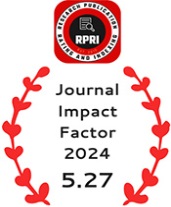Comparative Study of Speed and Agility Across Different Playing Positions
DOI:
https://doi.org/10.55544/ijrah.4.5.20Keywords:
Speed, Agility, Defenders, mid-field & forward Football playersAbstract
The purpose of the present study is to find out the correlation between Physical variables and different playing positions in football. The objective of this study is to examine and compare the speed and agility of district-level football players across different playing positions: defenders, midfielders, and forwards. Speed and agility are critical physical attributes that contribute significantly to a football player's performance, and understanding their variation across positions can provide valuable insights into position-specific training and talent identification. A sample of 90 players from Bhopal district-level teams was selected for the study, and their speed and agility were assessed through standardized tests such as the 50-meter sprint test for speed and the Shuttle Run Agility Test for agility.
The results reveal significant differences in both speed and agility between playing positions. Forwards demonstrated the highest average speed, which is essential for offensive runs and goal-scoring opportunities, while midfielders exhibited superior agility, reflecting their need to navigate tight spaces and switch directions frequently during the game. Defenders displayed moderate levels of both attributes, balancing the need for speed in counterattacks and agility in defensive maneuvers.
The findings suggest that position-specific physical training could enhance the performance of football players, and coaches should consider these differences when developing conditioning programs. This comparative analysis highlights the importance of tailoring speed and agility training to the specific positional requirements, which could lead to better overall team performance.
Downloads
References
Sebastiá-Rico, J.; Martínez-Sanz, J.M.; González-Gálvez, N.; Soriano, J.M. (2023) Differences in Body Composition between Playing Positions in Men’s Professional Soccer: A systematic review with Meta-Analysis. Appl. Sci., 13, 4782.
Diogo V. Martinho, Adam Field, André Rebelo, Élvio R. Gouveia, and Hugo Sarmento. (2023) A Systematic Review of the Physical, Physiological, Nutritional and Anthropometric Profiles of Soccer Referees. Martinho et al. Sports Medicine
Zúñiga-Vergara iPedro, Villaseca-Vicuña Rodrigo, Burboa Jair. (2022) anthropometric profile and physical fitness performance comparison by game position and connections with performance parameters in official images of Chilean men rugby players. Journal of Physical Education and Sport® (JPES), Vol. 22 (issue 10), Art 313, pp. 2454-2464,
Spehnjak, M. et al., (2021) Body composition in elite soccer players from youth to senior squad. Int. J. Environ. Res. Public Health, 18, 4982.
Dr. Amandeep Singh and Vikesh Kumar. (2019) The relationship of anthropometric characteristics with physical fitness performance is among the players. International Journal of Yogic, Human Movement, and Sports Sciences; 4(1): 515-517.
Dodd, K.D.; Newans, T.J., (2018) Talent identification if or isoccer: physiological aspects. J. Sci. Med. Sport, 21, 1073–1078.
Lukaski, H.C. (2017) Body Composition: Health and Performance in Exercise and Sport, 1st ed.; CRC Press: Boca Raton, FL, USA,; ISBN 1498731686.
Kanehisa, H.; Ikegawa, S.; Tsunoda, N.; Fukunaga, T. (1994) Cross-sectional fat and muscle areas in limbs during growth and middle age. Int. J. Sports Med., 15, 420–425.
Downloads
Published
How to Cite
Issue
Section
License
Copyright (c) 2024 Chetan, Dr. Vikas Saxena

This work is licensed under a Creative Commons Attribution-NonCommercial-NoDerivatives 4.0 International License.




















